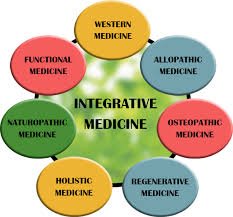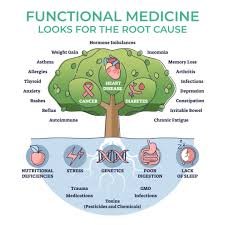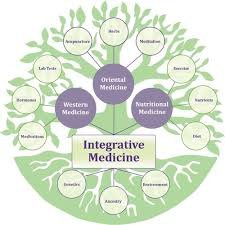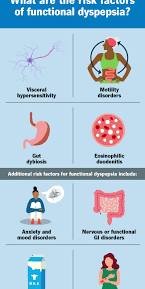Integrated medicine
Integrated Medicine
Integrative medicine is a holistic approach to healthcare that combines conventional medical treatments with complementary therapies to address the physical, emotional, and spiritual needs of patients.
Definition and Principles
Key Components
- Combination of Therapies: Integrative medicine incorporates both conventional treatments (like medications and surgeries) and complementary therapies (such as acupuncture, yoga, and herbal medicine) to enhance healing and well-being.
- Holistic Focus: The approach addresses not only physical health but also mental, emotional, and spiritual aspects, recognizing that these elements are interconnected and essential for overall health.
- Patient-Cantered Care: Patients are active participants in their healing process, working collaboratively with healthcare providers to create personalized treatment plans that suit their individual needs.
Benefits
- Comprehensive Care: Integrative medicine aims to provide a more comprehensive treatment plan that can lead to improved health outcomes, especially for chronic conditions like cancer, chronic pain, and anxiety.
- Enhanced Quality of Life: By addressing multiple aspects of health, patients often experience better quality of life, reduced symptoms, and improved emotional well-being.






Types of Practitioners
Integrative medicine can involve a variety of healthcare providers, including:
- Physicians
- Chiropractors
- Acupuncturists
- Nutritionists
- Psychotherapist
Conclusion
Integrative medicine represents a shift towards a more holistic and patient-centred approach to healthcare, aiming to treat the whole person and not just the disease. By combining conventional and complementary therapies, it seeks to optimize health and promote healing in a comprehensive manner.

What is integrative medicine?
Integrative medicine focuses on you as a whole person and not just your illness or disease. While it seeks to understand the underlying cause of your symptoms or condition, it does so by looking at your complete mind, body and spirit. Integrative medicine uses an evidence-based approach to improve your health and wellness.
Integrative medicine believes your physical, mental, emotional and spiritual needs affect your health. It believes those needs rely on each other and affect your entire well-being. There are many different aspects to address, so integrative medicine uses a combination of therapies and lifestyle changes.
With integrative medicine, the relationships between you and your healthcare providers are important. You are equal partners in your healing process. Integrative medicine aims for well-coordinated care among different providers and specialists. It brings together conventional healthcare approaches (like medication and psychotherapy) and complementary therapies (like acupuncture and yoga). In this way, integrative medicine “integrates” all aspects of your well-being to achieve optimal health and healing.
What type of providers deliver integrative medicine?
A variety of healthcare providers delivers care through integrative medicine. These providers may include:
- Physicians.
- Chiropractic doctors.
- Holistic mind-body psychotherapists.
- Acupuncturists
- Chinese herbal therapists.
- Tai chi practitioners.
- Yoga practitioners.
- Massage therapists.
- Nutritionists.
- Chefs (culinary medicine).
How can integrative medicine help me?
Integrative medicine physicians don’t replace your primary care provider or specialist. They work together with all members of your healthcare team to heal your mind, body and spirit. Their expertise lies in preventing and managing chronic diseases. They don’t treat acute medical problems. For acute care and medical emergencies, you should seek help from your primary care or emergency medicine physician.
Who is integrative medicine for?
Many people can benefit from integrative medicine, including healthy people. People with long-lasting (chronic) or complex conditions may especially find the approach helpful. Integrative medicine can help you find relief for many health and medical conditions, including:
- Autoimmune diseases.
- Acute and chronic pain.
- Breathing disorders.
- Headaches and migraines.
- Cancer and cancer-related side effects.
- Chronic fatigue.
- Cold/flu symptoms.
- Digestive disorders.
- Infertility.
- Menopausal symptoms.
- Menstrual issues.
- Mental and emotional health issues.
- Obesity.
- High blood pressure (hypertension).
- Sleep issues.
Treatment Details
What types of integrative medicine are available?
Integrative medicine covers a broad range of practices, techniques and services. Integrative medicine techniques may include:
Acupuncture
Acupuncture uses thin needles to maintain the flow and balance of your body’s energy (Qi). This can help activate your body’s natural healing capability. Acupuncture may help relieve:
- Joint pain.
- Fibromyalgia.
- Migraines.
- Cancer-related symptoms.
- Anxiety and depression.
- Hot flashes.
- Fatigue.
Culinary medicine
Culinary medicine combines the evidence-based science of food, nutrition and medicine with the joy and art of cooking. It may use special diets, including vegan, low-carb and FODMAP to improve your wellness. Culinary medicine can help improve and/or reverse common chronic diseases. These conditions include:
- Diabetes.
- High blood pressure (hypertension).
- Obesity.
- Non-alcoholic fatty liver disease.
Massage therapy
Massage therapy uses soft tissue manipulation and body movement to promote health and well-being. It can help treat physical disorders and improve clinical outcomes. Massage therapists can use different techniques to relieve:
Yoga and tai chi
Yoga and tai chi combine specific postures and movements with breathing to unify your mind and body. They may help:
- Reduce stress and pain.
- Enhance immune response.
- Lower blood pressure.
- Improve posture and body alignment.
- Increase muscle strength.
- Provide a sense of joy and well-being.
Chinese herbal therapy
Certified Chinese herbalists use formulas from a traditional Chinese medicine text. It contains thousands of herbs, minerals and other extracts and their intended uses. Chinese herbal therapy may help relieve:
- Fatigue.
- Digestive disorders.
- Pain.
- Menopausal symptoms.
- Cold/flu symptoms.
Chiropractic therapy
Chiropractic doctors perform soft tissue adjustments and manipulate your spine and joints. Chiropractic therapy may help relieve:
- Back and neck pain.
- Pelvic pain.
- Shoulder, elbow and wrist pain.
- Knee, hip or ankle pain.
- Other musculoskeletal problems.
Holistic psychotherapy
Holistic psychotherapy uses evidence-based therapies to improve mood, anxiety, post-traumatic stress disorder (PTSD) and other symptoms. These therapies include:
- Traditional talk therapy.
- Hypnosis.
- Hypnotherapy
- Cognitive behavioural techniques like breathing and relaxation.
- Guided imagery.
Reiki
Reiki is a method of energy healing that involves balance. It restores your body’s natural energy fields. It can increase vitality, balance your emotions and improve your health. Reiki may help relieve symptoms of various conditions. These may include:
- Cancer. When Chemotherapy has been advised by the Surgeon ,we can give better treatment.
- Chronic pain.
- Stress.
- Infertility
- Digestive disorders.
- Parkinson’s disease.
Integrative Health
Integrative health brings conventional and complementary approaches together in a coordinated way. Integrative health also emphasizes multimodal interventions, which are two or more interventions such as conventional health care approaches (like medication, physical rehabilitation, psychotherapy), and complementary health approaches (like acupuncture, yoga, and probiotics) in various combinations, with an emphasis on treating the whole person rather than, for example, one organ system. Integrative health aims for well-coordinated care among different providers and institutions by bringing conventional and complementary approaches together to care for the whole person.
The use of integrative approaches to health and wellness has grown within care settings across the United States. Researchers are currently exploring the potential benefits of integrative health in a variety of situations, including pain management for military personnel and veterans, relief of symptoms in cancer patients and survivors, and programs to promote healthy behaviors.
What is whole person health?
Whole person health refers to helping individuals, families, communities, and populations improve and restore their health in multiple interconnected domains—biological, behavioral, social, environmental—rather than just treating disease. Research on whole person health includes expanding the understanding of the connections between these various aspects of health, including connections between organs and body systems.
Chronic pain is a common problem among active-duty military personnel and veterans. NCCIH, the U.S. Department of Veterans Affairs, and other agencies are sponsoring research to see whether integrative approaches can help. For example:
An NCCIH-funded study is developing an innovative, collaborative treatment model involving chiropractors, primary care providers, and mental health providers for veterans with spine pain and related mental health conditions.
Other NCCIH-funded studies are testing the effects of adding mindfulness meditation, self-hypnosis, or other complementary approaches to pain management programs for veterans. The goal is to help patients feel and function better and reduce their need for pain medicines that can have serious side effects.
Complementary and alternative medicine (CAM) is the term for medical products and practices that are not part of standard medical care. People with cancer may use CAM to
help cope with the side effects of cancer treatments, such as nausea, pain, and fatigue
comfort themselves and ease the worries of cancer treatment and related stress
feel that they are doing something to help with their own care
try to treat or cure their cancer
Integrative medicine is an approach to medical care that combines conventional medicine with CAM practices that have shown through science to be safe and effective. This approach often stresses the patient’s preferences, and it attempts to address the mental, physical, and spiritual aspects of health.
Conventional medicine is a system in which health professionals who hold an M.D. (medical doctor) or D.O. (doctor of osteopathy) degree treat symptoms and diseases using drugs, radiation, or surgery. It is also practiced by other health professionals, such as nurses, pharmacists, physician assistants, and therapists. It may also be called allopathic medicine, biomedicine, Western, mainstream, or orthodox medicine. Some conventional medical care practitioners are also practitioners of CAM.
Standard medical care is treatment that is accepted by medical experts as a proper treatment for a certain type of disease and that is widely used by healthcare professionals. Also called best practice, standard of care, and standard therapy.
Complementary medicine is used along with standard medical treatment but is not considered by itself to be standard treatment. One example is using acupuncture to help lessen some side effects of cancer treatment. Less research has been done for most types of complementary medicine.
Alternative medicine is used instead of standard medical treatment. One example is using a special diet to treat cancer instead of cancer drugs that are prescribed by an oncologist. Less research has been done for most types of alternative medicine.
Types of Complementary and Alternative Medicine
Scientists learn about CAM therapies every day, but there is still more to learn. This list is meant to be an introduction to what types of CAM are practiced, not an endorsement. Some of the therapies listed below still need more research to prove that they can be helpful. If you have cancer, you should discuss your thoughts about using CAM with your health care provider before using the therapies listed below.
People may use the term “natural,” “holistic,” “home remedy,” or “Eastern Medicine” to refer to CAM. However, experts often use five categories to describe it. These are listed below with examples for each.
Mind–body therapies
These combine mental focus, breathing, and body movements to help relax the body and mind. Some examples are
meditation: focused breathing or repetition of words or phrases to quiet the mind and lessen stressful thoughts and feelings.
biofeedback: using special machines, the patient learns how to control certain body functions that are normally out of one’s awareness (such as heart rate and blood pressure).
hypnosis: a trance-like state in which a person becomes more aware and focused on certain feelings, thoughts, images, sensations or behaviors. A person may feel more calm and open to suggestion in order to aid in healing.
yoga: ancient system of practices used to balance the mind and body through stretches and poses, meditation, and controlled breathing
tai chi: a form of gentle exercise and meditation that uses slow sets of body movements and controlled breathing
imagery: focusing on positive images in the mind, such as imagining scenes, pictures, or experiences to help the body heal
creative outlets: interests such as art, music, or dance
Biologically based practices
This type of CAM uses things found in nature. Some examples are
vitamins: nutrients the body needs in small amounts to function and stay healthy
dietary supplements: products added to the diet that may contain ingredients such as vitamins, minerals, and herbs, to name a few
botanicals: plants or parts of plants. One type is cannabis.
herbs and spices such as turmeric or cinnamon (See Herbs at a Glance)
special foods or diets.
